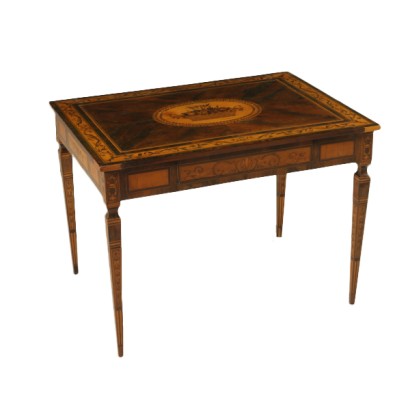Writing table
Features
Style: Neo-Classical (1765-1790)
Age: 18th Century / 1701 - 1800
Origin: Firenze, Toscana, Italy
Main essence: Rosewood , Poplar
Material: Solid Maple , Rosewood Veneer
Description
Desk is held up by four legs, trunk-pyramidal, with throttling of the connection to the bands. In the front of the removable tray. The entire surface is veneered in rosewood with reserves in maple are contained in threads, multicolored made of maple, stained maple and green walnut of india. The reserves are enriched by inlays of polychrome wood in the strips and on the legs, depicting shells, stylized vases, and spirals fogliacee. At the center of the floor, enclosed in a frame unghiata, is inlaid on a background of light maple, and a basket of flowers and fruits, made of polychrome wood; the edges of the floor, a large reserve inlaid with spirals of twigs framing the whole. Wood interior gattice. The legs are missing the typical lens blower machined which acts as a pin, probably cut because worn.
Product Condition:
Product in good condition, has small signs of wear and tear.
Dimensions (cm):
Height: 71,5
Width: 98
Depth: 72
Certificate issued by: Enrico Sala
Additional Information
Notes historical bibliographic
This is without the particular doubt of the furniture made by the workshop of Marco Calestrini in Florence in the last quarter of the EIGHTEENTH century. Typical, not only the inlay, the pattern of the basket and the frame fogliacce that we find in his other productions, but also the choices of color , this clever alternating of light and dark woods, dyed according to a taste very anglo-saxon. The production of the desks of Calestrini had great success among the English in Florence, and were often intended for export. The labeling of the legs is in fact typical of that production, which was sent via ship disassembled and then reassembled and glued to the target. For the bibliography, please refer to: Simone Chiarugi, Botteghe di mobilieri in Toscana 1780 - 1900, ed. S. P. E. S. 1994, Enrico Colle, Il mobile neoclassico in Italia, ed. Electa 2005Style: Neo-Classical (1765-1790)
This historical period includes a first phase that can be properly defined as the Louis XVI style.nOnly at a later time, with the maturation of archaeological fashions, was a new vision of furnishing civilization formulated and codified, now fully attributable to the Neoclassical Style.
In fact, both trends coexisted in unison until the last years of the eighteenth century.
nIn the field of cabinet making, the Directoire, Retour d'Egypte, Consular and Empire styles also fall within the neoclassical era.
nFind out more about Neoclassicism with the insights from our blog...
n
































